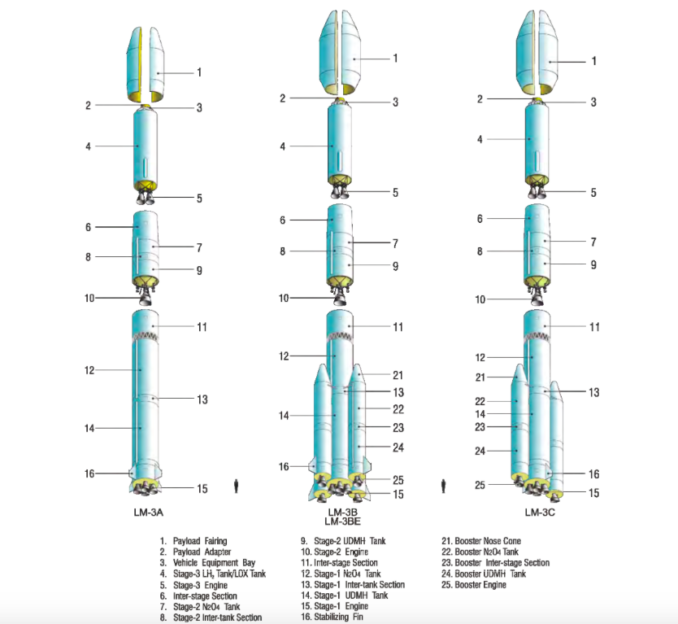Lift Off Time | December 29, 2021 – 16:43 UTC December 30, 2021 – 00:43 BJT |
|---|---|
Mission Name | TJSW-9, a communication technology experiment satellite |
Launch Provider | China Great Wall Industry Corporation (CGWIC) |
Customer | Chinese Ministry of Defense |
Rocket | Long March 3B/E |
Launch Location | LC-2, Xichang Satellite Launch Center, China |
Payload mass | Unknown, up to 5,500 kg (12,100 lb) to GTO |
Where did the satellite go? | Geostationary Earth Orbit (initial orbit: Geostationary Transfer Orbit) |
Did they attempt to recover the first stage? | No, the Long March 3B is not capable of booster recovery |
Where did the first stage land? | It will crash back over land in North-West China |
Did they attempt to recover the fairings? | No, the Long March 3B is not capable of fairing recovery |
Were these fairings new? | Yes |
This was the: | – 141st flight of a Long March 3 (any variant) – 55th and final Chinese orbital launch attempt of 2021 – 143rd orbital launch attempt of 2021 |
Where to watch | No replay of this launch is available |
What’s This All Mean?
The China Great Wall Industry Corporation successfully launched the Tongxin Jishu Shiyan Weixing-9 (TJSW-9) satellite atop a Long March 3B/E. The TJSW-9 satellite is a classified communication technology experiment satellite, thought to be for the Chinese military.
TJSW-9 Satellite
The TJSW-9 satellite is the ninth satellite in the TJSW constellation. The Chinese media has stated that the satellite will be used for communications, data transmission for radio, and technical tests. However, the true nature of the satellite is thought to be part of China’s early ICBM warning system, which would explain the heavily classified nature of the satellite.
What Is The Long March 3B?
Despite the Chinese rockets having different heritages, most of China’s orbital launch vehicles use the “Long March” (Chang Zheng) naming scheme. The Long March 3B is a three stage rocket, with an optional fourth stage. The rocket has four liquid-fueled side boosters, and first launched in 1996.
The Long March 3B/E, the enhanced version of the Long March 3B, was first launched in 2007 and has greater Geostationary Transfer Orbit (GTO) payload capacity. The enhanced 3B/E’s have a larger first stage and larger side boosters, compared to the original Long March 3B. As a result, its payload capacity to GTO was increased from 5,100 kg to 5,500 kg.
The Long March 3B series features the following sections or stages:
- Side boosters
- First (center) stage (ignited at launch)
- Second stage
- Third stage
- Optional fourth stage
Side Boosters
There are 4 side boosters that each use one YF-25 engine, which is powered by Unsymmetrical Di-Methyl Hydrazine (UDMH) and Nitrogen Tetroxide (N2O4).
The regular Long March 3B’s side boosters are 15.33 m (50.3 ft) long, but on the enhanced version they are 16.1 m (52.3 ft) long, producing 740 kN of thrust. The YF-25 engine has a specific impulse (ISP) of 260 seconds, and burns for 140 seconds on the 3B/E variant.
First (Center) Stage
The first stage has 4 YF-21C engines, which also use UDMH / N2O4 for propellant. The first stage has an ISP of 260 seconds and produces 2,960 kN of thrust. The LM-3B first stage is 23.27 m (76.35 ft) tall, but the 3B/E is 24.76 m (81.23 ft) tall.

Second Stage
The second stage is powered by a single YF-22E engine. However, attitude control is provided by a single YF-23 Vernier engine, and combined, these engines are known as a YF-24 module. The engine runs on UDMH and N2O4 and produces 742 kN of thrust. The second stage is 12.9 m (42.3 ft) tall and burns for 185 seconds.

Third Stage
The third stage is 12.4 m (40.7 ft) long and is powered by 2 YF-75 engines. Unlike the other stages, this stage is powered by liquid hydrogen (LH2) and liquid oxygen (LOX).
The third stage will burn after the second stage is jettisoned, in order to continue to raise the orbital apogee (maximum altitude). Once the target apogee has been achieved, it shuts down. The vehicle will then coast to apogee, where the stage relights and burns to raise the perigee (lowest altitude) of the orbit.
Optional Fourth Stage
The fourth stage runs on UDMH / N2O4, and has a singular YF-50D engine.





